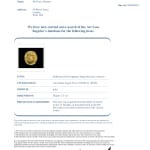Hellenistic Gold Applique Depicting Zeus Ammon, 300 BCE - 100 BCE
Gold
height 3.3 cm
height 1 1/4 in
height 1 1/4 in
LO.630
The Ancient Egyptian oracle god Amun had his main sanctuary in the Siwa oasis, some five hundred kilometers west of Memphis. Originally, the Libyan desert tribes worshipped a god in...
The Ancient Egyptian oracle god Amun had his main sanctuary in the Siwa oasis, some five hundred kilometers west of Memphis. Originally, the Libyan desert tribes worshipped a god in the form of a ram here. Eventually, the cult was overtaken by the Egyptians who identified the god with their supreme deity Amun. The first Greeks to visit the shrine came from the city-state of Cyrenaica, calling the god Zeus Ammon.
Historical texts indicate that the cult began to spread outside of Egypt by the 6th Century B.C. During the 5th Century, the poet Pindar glorified Zeus Ammon in odes and Greek military commanders sent delegations to Siwa to consult the oracle before embarking upon campaigns. By the time of Alexander’s conquest of Egypt, the oracle was a compulsory stop. Alexander considered himself the divine offspring of Zeus, and thereby Zeus Ammon. As a divine king, Alexander was a worthy successor to the pharaoh. In effect, his visit to the oracle was more political than religious. Yet Alexander was more than happy to play up this association and was even said to wear the horns of the ram during public occassions to honor his father Zeus Ammon. He would be depicted this way on much of his coinage.
This small, round gold applique depicts a bust of Zeus Ammon slightly turned to the left. His hair is parted down the middle. Curls cover his forehead and flow into the spiraling ram horns of Amun. Yet, he also has the long beard and stoical features of Zeus. This gorgeous applique was once likely a central element in a piece of jewelry. Although it was crafted in Alexandria, it may have been intended for a far away port where this deity was also worshipped.
Historical texts indicate that the cult began to spread outside of Egypt by the 6th Century B.C. During the 5th Century, the poet Pindar glorified Zeus Ammon in odes and Greek military commanders sent delegations to Siwa to consult the oracle before embarking upon campaigns. By the time of Alexander’s conquest of Egypt, the oracle was a compulsory stop. Alexander considered himself the divine offspring of Zeus, and thereby Zeus Ammon. As a divine king, Alexander was a worthy successor to the pharaoh. In effect, his visit to the oracle was more political than religious. Yet Alexander was more than happy to play up this association and was even said to wear the horns of the ram during public occassions to honor his father Zeus Ammon. He would be depicted this way on much of his coinage.
This small, round gold applique depicts a bust of Zeus Ammon slightly turned to the left. His hair is parted down the middle. Curls cover his forehead and flow into the spiraling ram horns of Amun. Yet, he also has the long beard and stoical features of Zeus. This gorgeous applique was once likely a central element in a piece of jewelry. Although it was crafted in Alexandria, it may have been intended for a far away port where this deity was also worshipped.



